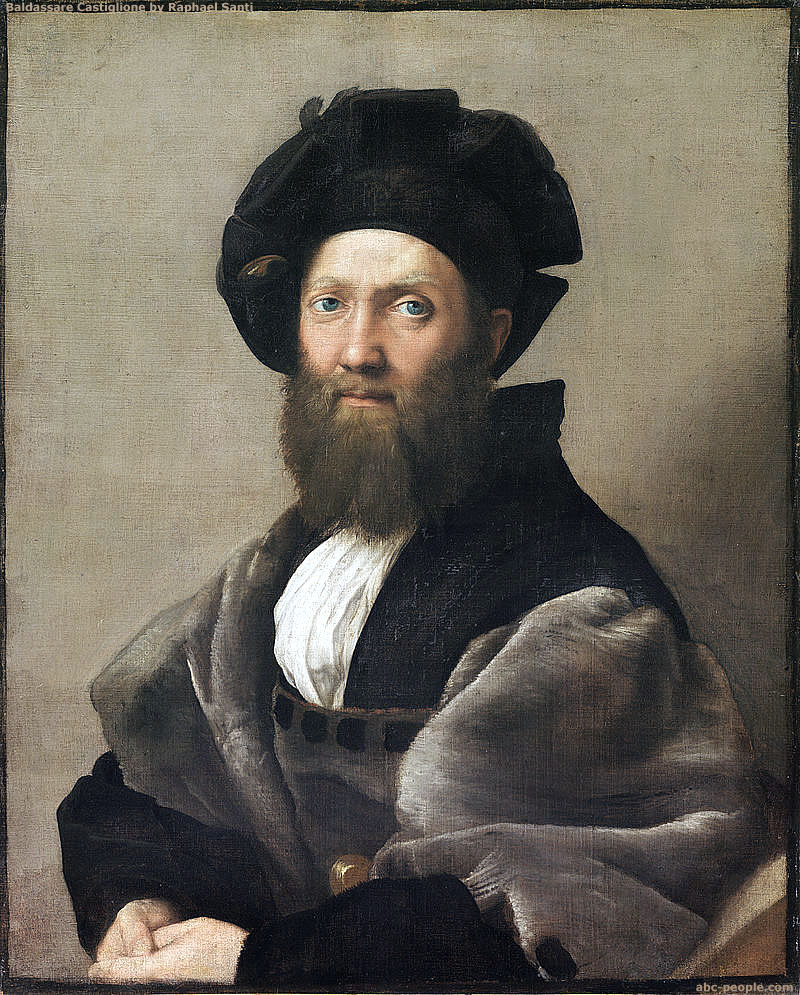| Raphael's
Masterpieces |
|
Baldassare
Castiglione |
||
|
About
picture |
Distinguishing
features |
Baldassare Castiglione - Bio |
| |
|
|
The portrait's subject is Baldassare Castiglione (1478–1529), poet, humanist, and ambassador, whom Raphael first met as a young man in Urbino. Famous for writing The Courtier, published in 1528 and dedicated to describing the ideal man of the court, Castiglione found a friend in Raphael, both men sharing the same ideas regarding beauty and harmony. The
courtier incarnate A
natural portrait |
| |
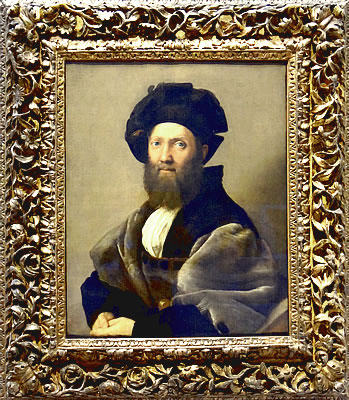
"Portrait of Baldassare Castiglione" by Raphael in Louvre, Paris |
Distinguishing features There is an emotional openness and beguiling humanity to this painting that characterises Raphael's later portraits in particular. Castiglione looks vulnerable and sensitive, and his yielding clothes - the rich, silky grey fur, the creamy, billowing cloth at his throat, his dark velvety hat and not least his beard, trimmed but round and blurred - suggest softness, subtlety of character, the very traits that Castiglione recommended. This is a civilised painting of a man who offers himself to us as an equal, to talk to, with whom to reach an intelligent accord. This was a radical cultural transformation in a world where rape was a recognised military tactic, where sufferers from plague were abandoned by their families, and where, in a letter of 1501, the brother of the explorer Vespucci reports that a woman was burned at the stake in Rome for "sodomy". It's important to acknowledge the absolute mastery of this painting, its quiet confidence in the modelling of figure, the spatial quality, the daringly muted tones - above all, the sensitivity both suggested and achieved. Inspirations and influences: Rubens, a courtier and a pacifist, painted a copy of this seminal portrait, today in London's Courtauld Gallery. Jonathan Jones - Theguardian |
| |
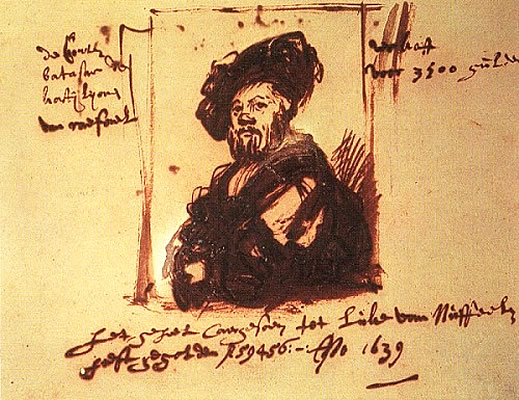 |
Baldasar
Castiglione by Rembrandt 9
April 1639 in the Keizersgracht house Lucas van Uffelen’s
collection was auctioned. In today’s terms we would call
it the “sale of the century”. |
Rumor has it that ... Interestingly
enough, Raphael’s masterful portrait was inspired by his study
of the composition
Pen and ink sketch of a ‘Young Woman on a Balcony’ by Raphael, executed c. 1504 in Florence where he apprenticed himself for a time at Leonardo’s studio. The sketch was most likely directly influenced by Leonardo’s ‘Earlier Mona Lisa‘. The flanking columns, the background landscape and the youthful demeanor of the model serve to confirm this. |
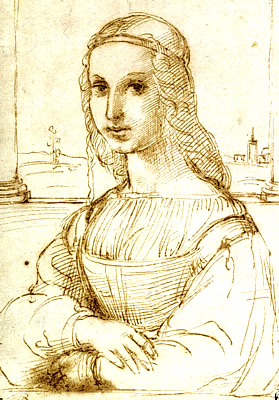
|
| |
Baldassare
Castiglione Baldassare Castiglione, (born December 6, 1478, Casatico, near Mantua [Italy], died February 2, 1529, Toledo [Spain]) Italian courtier, diplomat, and writer best known for his dialogue "Il libro del cortegiano", 1528. (Alternative Titles: “Cortegiano”, “Il cortegiano”, “Il libro del cortegiano”, “The Book of Courtesy”, “The Book of the Courtier”, “The Courtyer”). The son of a noble family, Castiglione was educated at the humanist school of Giorgio Merula and Demetrius Chalcondyles, and at the court of Ludovico Sforza in Milan. He returned to Mantua in 1499 to enter the service of the marquis, Francesco Gonzaga, transferring to the service of Guidobaldo da Montefeltro, duke of Urbino, in 1504. Among his duties was a mission to England to receive the Order of the Garter as a proxy for Guidobaldo. It was at Urbino that Castiglione collaborated with his cousin on a pastoral drama, Tirsi, in which the speeches of nymphs and shepherds conceal references to the court. Castiglione was sent to Rome in 1513 as ambassador of the new duke of Urbino, Francesco Maria della Rovere, and later entered papal service. He knew the master painter and architect Raphael and collaborated with him on a memorandum regarding the preservation of the city’s antiquities. Castiglione was posted to Spain as papal nuncio (ambassador) in 1525 and apparently impressed Emperor Charles V as a perfect gentleman. |
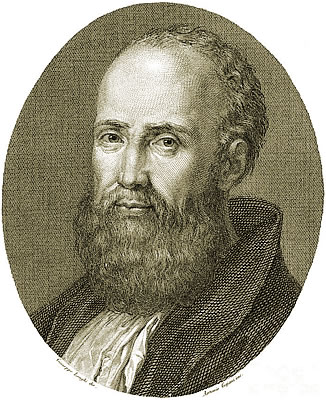 |
| Written in 1513–1518, "Il libro del cortegiano" was published in Venice in 1528. It is a discussion of the qualities of the ideal courtier, put into the mouths of such friends as Pietro Bembo, Ludovico da Canossa, Bernardo da Bibbiena, and Gasparo Pallavicino. The dialogue claims to represent conversations at the court of Urbino on four successive evenings in 1507, with the duchess Elisabetta Gonzaga and her “lieutenant,” Lady Emilia, in the chair. Its main themes include the nature of graceful behaviour, especially the impression of effortlessness (sprezzatura); the essence of humour; the best form of Italian to speak and write; the relation between the courtier and his prince (stressing the need to speak frankly and not to flatter); the qualities of the ideal court lady (notably “a discreet modesty”); and the definition of honourable love. As was common in the Renaissance, "Il cortegiano" freely imitates the work of ancient writers such as Plato (on the ideal republic) and Cicero (on the ideal orator) as well as discussing the problem of creative imitation. It also has its place in a late medieval tradition of courtesy books, manuals of noble behaviour. At the same time, it is a nostalgic evocation of the court of Urbino as it was in Castiglione’s youth, a “portrait” in the manner of Raphael of the duchess and of his friends, many of whom were dead by the time the book was published. Further, Castiglione invests "Il cortegiano" with an unusual lightness that both describes sprezzatura and exemplifies it, and a lively dialogue that brings his leading characters to life. "Il cortegiano" was a great publishing success by the standards of the time. It was written for and read by noblewomen, including the poet Vittoria Colonna, Isabella d’Este, marchioness of Mantua, and the author’s mother, as well as by men. In the century after its publication, it averaged an edition a year and was translated into Spanish (1534), French (1537), Latin (1561), and German (1565), besides the English version by Sir Thomas Hoby, The Courtyer of Count Baldessar Castilio (1561), and the Polish adaptation by Lukasz Górnicki, Dworzanin polski (1566; “The Polish Courtier”). Copies of Castiglione’s book can be found in libraries from Portugal to Hungary and from Sweden to Sicily. English readers included politicians such as Thomas Cromwell and Sir Christopher Hatton, intellectuals such as Roger Ascham, Robert Burton, and Francis Bacon, and perhaps writers such as Sir Philip Sidney and William Shakespeare. The book remains a classic of Italian literature. Castiglione’s apparent intention was to raise problems (Does a courtier need to be of noble birth? Is his primary occupation warfare? and so on), leaving them deliberately unresolved. However, his 16th-century readers, responding to the cues given by editors who furnished the book with marginal notes and summaries as well as indexes, appear to have read the book as a treatise on the art of shining in society. It was studied by lawyers and merchants who wished to appear well-bred (whether the author would have approved of this use of his dialogue is doubtful). The underlining in surviving copies suggests that some readers paid closer attention to the jokes and instructions on how to ride or dance with elegance than the more philosophical debates. The
text survived the Counter-Reformation with minor expurgations, such
as the deletion of anticlerical jokes and references to the pagan
goddess Fortune. Eclipsed by rival and more up-to-date treatises
on behaviour in the 17th and 18th centuries (despite interest in
the book on the part of Lord Chesterfield, Samuel Johnson, and the
actor David Garrick), "Il cortegiano" was rediscovered
in the late 19th century as a representative text of the Renaissance. |
|
| Copyright
© 2004 abc-people.com Design and conception BeStudio © 2014-2023 |
